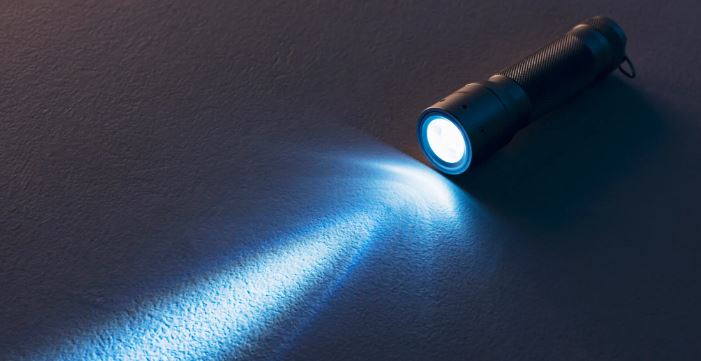
At the core of an LED flashlight lies the light-emitting diode (LED), a semiconductor device that converts electricity into light. Compared to traditional incandescent bulbs, which rely on a filament that gets hot to create light, LEDs create light through a process called electroluminescence. This fundamental difference in technology is what sets LED flashlights distinct from their predecessors, offering many advantages that have made them the chosen choice for various applications.
Benefits of LED Flashlights
One of the key benefits of LED flashlights is their exceptional energy efficiency. LEDs use significantly less power than incandescent bulbs, enabling them to operate for extended periods on a single set of batteries. This efficiency results in prolonged runtime, making LED flashlights optimal for situations where reliable, durable illumination is essential, such as camping trips, power outages, or emergency situations. Moreover, the decreased power consumption of LEDs means that users can reduce expenses on replacement batteries, making them a cost-effective choice in the long run.In addition to their energy efficiency, LED flashlights are renowned for their resilience and resilience. Traditional incandescent bulbs are delicate and vulnerable to breakage, especially when exposed to shock or vibration. Conversely, LEDs are robust devices with no moving parts or fragile filaments, making them extremely resistant to impact and vibration. This rugged construction allows LED flashlights to endure the challenges of outdoor use, including unintentional drops, bumps, and exposure to extreme weather conditions. Whether you're hiking through rough terrain, working on a construction site, or simply navigating a dark path, an LED flashlight can provide reliable illumination without the concern of abrupt failure.
Another advantage of LED flashlights is their remarkable brightness and beam quality. Developments in LED technology have led to the creation of powerful LEDs that can create bright, focused beams of light. These mighty LEDs, combined with carefully designed reflectors and lenses, allow LED flashlights to generate a bright, uniform beam that can illuminate objects at a significant distance. The ability to project a powerful, focused beam is especially valuable in outdoor settings, where users need to recognize potential hazards or navigate through dim, new environments. Furthermore, many LED flashlights offer customizable beam patterns, allowing users to switch between an expansive flood beam for close-up work and a focused spot beam for distant illumination, providing flexibility for different lighting needs.
The compact size and light design of LED flashlights are also substantial advantages over their incandescent counterparts. LEDs are much smaller than traditional bulbs, enabling manufacturers to create flashlights that are more portable and easier to carry. This portability is notably beneficial for specialists who need to bring a flashlight as part of their regular gear, such as law enforcement officers, firefighters, and utility workers. The featherweight nature of LED flashlights also makes them more comfortable to hold and use for lengthy periods, minimizing hand fatigue and strain.
In terms of longevity, LED flashlights have an obvious edge over incandescent models. LEDs have a remarkable lifespan, often enduring tens of thousands of hours before requiring replacement. This extended lifespan means that users can rely on their LED flashlights for years without the need for frequent bulb changes. Conversely, incandescent bulbs have a significantly briefer lifespan, typically enduring only a few hundred hours before burning out. The prolonged lifespan of LEDs not only provides simplicity but also contributes to the general cost-effectiveness of LED flashlights, as users can evade the expense and bother of constantly replacing bulbs.
Adaptability and Uses
The flexibility of LED flashlights surpasses their primary function of providing illumination. Many contemporary LED flashlights come equipped with extra features that enhance their functionality and adaptability. Some models include various lighting modes, such as intense, mid-level, and faint brightness settings, as well as strobe or SOS modes for emergency signaling. These varied lighting modes allow users to tailor the flashlight's output to fit their specific needs, preserving battery life when maximum brightness is not required. Additionally, some LED flashlights integrate rechargeable batteries, getting rid of the need for disposable batteries and providing a more green and cost-effective solution.The toughness and dependability of LED flashlights make them an essential tool in numerous professional fields. Law enforcement officers, for example, depend on LED flashlights for operational operations, suspect searches, and crime scene investigations. The intense, focused beam of an LED flashlight can help officers recognize potential threats and collect evidence in dim conditions. Similarly, firefighters and emergency responders use LED flashlights to maneuver through smoke-filled buildings, pinpoint victims, and analyze hazardous situations. The sturdy construction and water-resistant properties of many LED flashlights guarantee that they can withstand the severe conditions encountered in these demanding professions.

Outdoor enthusiasts, such as hikers, campers, and hunters, have also adopted LED flashlights as an essential part of their gear. The extended runtime and bright illumination provided by LED flashlights are indispensable when exploring remote wilderness areas, arranging camp in the dark, or tracking game during early morning or late evening hours. The small size and lightweight design of LED flashlights make them effortless to pack and carry, ensuring that outdoor adventurers always have a trustworthy source of light at their disposal.
In the realm of home and personal use, LED flashlights have become a necessity for emergency preparedness and everyday convenience. During power outages or natural disasters, an LED flashlight can provide crucial illumination, permitting families to cautiously navigate their homes, locate supplies, and communicate for help if needed. The extended runtime of LED flashlights assures that users have a dependable light source even during prolonged periods without electricity. Furthermore, LED flashlights are handy for numerous household tasks, such as inspecting dark corners, reading in dark conditions, or carrying out minor repairs in inadequately lighted areas. For more detailed information, reviews, and specifications, be sure to visit https://medium.com/@blackbookz.one/nitecore-edc27-3-000-lumen-flat-edc-rechargeable-flashlight-high-performance-compact-pocket-light-ecf750d57b54, where you can explore all the features and benefits that make the Nitecore EDC27 an exceptional lighting tool.